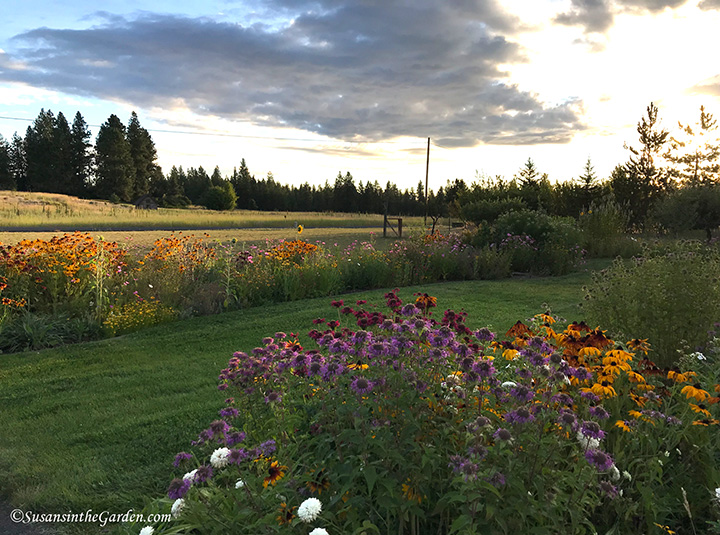June 20 Column: Pollinator Garden

Happy 2nd birthday to our pollinator garden! Since I get so many questions about it, I knew it was time to write a column and update you on how it’s doing. You can read it in today’s edition of The Spokesman-Review: Pollinator garden provides habitat for birds and insects – and beauty for humans. (or you can read my column at the bottom of this post)
Bill and I first installed the pollinator garden in May 2019. We’d been talking about creating one for a couple of years and finally got down to business. This involved removing a lot of sod, preparing the soil, and then making plant selections which was my favorite part.
I wanted to point you to the original blog post about creating our pollinator garden because it contains a plant list. It doesn’t contain absolutely everything I planted but it’s a good start. My goal was to choose plants with varying types of flower heads to accommodate the pollinators and beneficial insects’ mouth parts, which can be very different. Since we live in a dry region, I also focused on selecting drought-tolerant plants.
I have been astounded by this garden’s beauty and by the diversity of the bugs that visit it. Our pollinator garden has been a great learning tool. If you have already purchased my new book, The Vegetable Garden Pest Handbook, you’ve seen many of the photos of beneficial bugs that I took last summer.
(and if you don’t have my book, remember that you can purchase a signed copy from me. Just send me a note at Susan@SusansintheGarden.com and I’ll take care of it for you.)
It seems only fitting to have this week’s video focus on our pollinator garden as well. After all, you probably wanted to see what it looks like and how it’s doing, right? Enjoy:
And here is my column:
By Susan Mulvihill
For The Spokesman-Review
As I walk down the driveway to retrieve the morning paper, I notice the sun has popped up over the crest of the hill. It is backlighting leaves and flowers, accentuating their widely-varying textures, shapes and colors.
Early-rising bumblebees are already noisily buzzing about the deep purple lupine blossoms while a goldfinch hangs onto a spent flower stalk in search of seeds. The Western columbine is now in bloom, with its coral-and-yellow flowers gently nodding in the light breeze. I now realize I’ve stopped dead in my tracks to take in the beauty of the scene, eagerly scanning to see what’s happened since I last checked a mere 24 hours before.
This scenario has become a morning routine for me. Our pollinator garden is now officially two years old yet it continues to surprise me as it evolves. The amount of joy it brings me is incalculable. We didn’t create it for ourselves, though. It’s for the pollinators, the beneficial insects, the many species of birds that visit it on a regular basis – and maybe even a moose that will feast on the foliage in the fall when it won’t matter to me anymore.
In May 2019, my husband Bill and I decided it was time to get started on creating some colorful habitat in our front yard. The first task was removing quite a bit of our lawn which we were anxious to do since it provides very little habitat or food for beneficial insects.
Once we prepared the soil for planting, I focused on accumulating diverse types of blooming plants to attract good bugs such as bees, hoverflies, assassin bugs, big-eyed bugs, lacewings, ladybugs and parasitic wasps. The majority of beneficial insects require nectar and/or pollen during part of their life cycle. It’s important to note many of them have varying types of mouthparts; by planting many different types of flowers, we can accommodate all of them.
I chose an interesting combination of native plants, hardy perennials and a mix of wildflowers. The natives included alum root, Western aster, cinquefoil, Canadian and stiff goldenrod, white vervain, purple giant hyssop, Oregon sunshine, prairie smoke, blanketflower, different species of penstemon, and showy and whorled milkweed. The next additions were some pollinator-attracting perennials such as bee balm, Gloriosa daisy, black-eyed Susan and butterfly weed.
A large packet of wildflower seeds from American Meadows has provided the biggest surprises in our pollinator garden. The instructions recommended freely scattering the seeds onto the soil and pressing them into it rather than covering them. That was a leap of faith for me: I’m so used to planting seeds at specific depths and worried all of local birds would feast on them before they could germinate.
It turns out I needn’t have worried at all. Last year, we enjoyed California poppies, cosmos, godetia, sweet alyssum, lance-leaved coreopsis, partridge peas, and towering Maximilian sunflowers. So far this spring, the newest additions from last year’s seed-sowing include the biennials sweet William, orange Siberian wallflowers and lupines that have bloomed profusely.
At this point, I don’t think any more planting is in order so I’m just focusing my efforts on pulling any worrisome weeds that pop up and learning more about the amazing beneficial insects that have taken up residence.
As the pollinator garden comes into its own, I remind myself that I’m just the custodian of this magical place. A very lucky custodian indeed.
Susan Mulvihill is author of “The Vegetable Garden Pest Handbook.” She can be reached at Susan@susansinthegarden.com. Watch this week’s “Everyone Can Grow a Garden” video at youtube.com/susansinthegarden.

